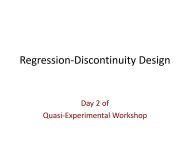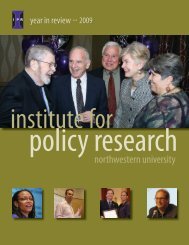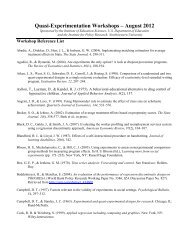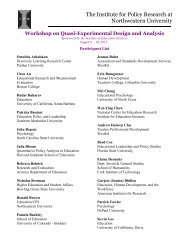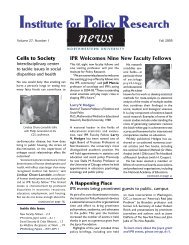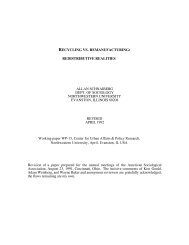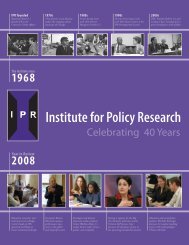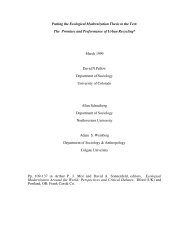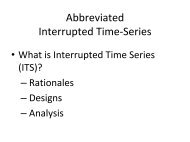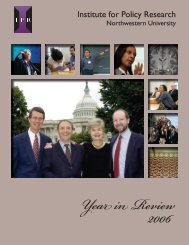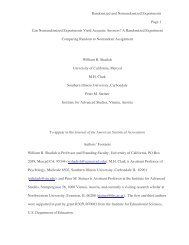Highlights of 2011 - Institute for Policy Research - Northwestern ...
Highlights of 2011 - Institute for Policy Research - Northwestern ...
Highlights of 2011 - Institute for Policy Research - Northwestern ...
You also want an ePaper? Increase the reach of your titles
YUMPU automatically turns print PDFs into web optimized ePapers that Google loves.
Social Disparities AND Health<br />
Middle Class and Marginal<br />
How does it feel <strong>for</strong> a student from a modest middle-class<br />
background to attend an elite private university? In work with<br />
IPR postdoctoral fellow Sarah Johnson and psychologist and IPR<br />
associate Eli Finkel, IPR social psychologist Jennifer Richeson<br />
investigates how students’ SES backgrounds, and their acute<br />
awareness <strong>of</strong> their status vis-à-vis peers, would influence their<br />
experiences in a context <strong>of</strong> privilege. The trio conducted four<br />
experiments to explore such students’ psychological burdens in<br />
terms <strong>of</strong> social identity threat, or how a lower-SES student might<br />
feel his or her identity threatened and devalued in a perceived<br />
higher-status environment. Prior research in this area has mainly<br />
focused on understanding “visible characteristics” <strong>of</strong> race and<br />
gender, not an invisible stigma such as socioeconomic status. In<br />
two <strong>of</strong> the studies, students made a presentation outlining their<br />
academic record, following which lower-SES students ate more<br />
candy and exhibited slower reaction times in a Stroop Test,<br />
which is used to measure executive function, compared with<br />
their higher-SES peers. This indicates more cognitive depletion.<br />
In contrast, there were no differences between students after a<br />
discussion <strong>of</strong> their geographic preferences, a nonacademic and<br />
nonstigmatizing topic. The results suggest what matters is not<br />
simply being a member <strong>of</strong> a stigmatized group but managing<br />
concerns about stigma. Even <strong>for</strong> relatively privileged groups (the<br />
middle-class students in this study were able to gain admittance<br />
to an elite university), managing feelings <strong>of</strong> inferiority in terms<br />
<strong>of</strong> academic achievement can leave students “ego depleted.”<br />
This sets them up to fail in fulfilling their potential, such as in<br />
completing class assignments, successfully navigating personal<br />
relationships, and avoiding unhealthy behaviors. The study was<br />
published in the Journal <strong>of</strong> Personality and Social Psychology.<br />
Acquiring Biological Understanding<br />
Psychologist and IPR associate Sandra Waxman continues<br />
her work into understanding how acquisition <strong>of</strong> fundamental<br />
biological concepts like “alive” and “die” are incredibly difficult<br />
and can affect children’s understanding <strong>of</strong> the natural world.<br />
In a paper published in the British Journal <strong>of</strong> Developmental<br />
Psychology, she and co-authors <strong>Northwestern</strong> postdoctoral<br />
fellow Erin Leddon and psychologist Douglas Medin compare<br />
how English- and Indonesian-speaking children pick up these<br />
two concepts. Past research has indicated that parents help<br />
shape such conceptualization in in<strong>for</strong>mal conversations at<br />
home. The researchers transcribed and coded 1.5 million<br />
words from child-parent conversations between Englishspeaking<br />
1- and 5-year-olds (1- to 4-year-olds <strong>for</strong> Indonesian<br />
speakers) and their parents every several weeks over nearly<br />
three years. Their main finding is that children do learn from<br />
their parents, but such understandings are heavily focused on<br />
animate objects such as humans and animals, <strong>of</strong>ten failing to<br />
show how plants are animate objects, too. Children, there<strong>for</strong>e,<br />
have to learn how to integrate in<strong>for</strong>mation from other sources<br />
to <strong>for</strong>m overarching biological concepts.<br />
Face Recognition and Other-Race Effect<br />
Why is it that people are less likely to remember a face from a<br />
racial group other than their own? A team <strong>of</strong> researchers that<br />
included neuroscientist and IPR associate Joan Chiao used EEG<br />
recordings to measure brain activity while people attempted<br />
to remember faces. They shed light on this well-documented<br />
phenomenon known as the “other-race effect” in which the<br />
brain works differently when memorizing the face <strong>of</strong> a person<br />
from one’s own race than a face from another race. Their biological<br />
evidence shows that brain activity increases in the first<br />
200 to 250 milliseconds after seeing a face, regardless <strong>of</strong> race.<br />
The brain activity showed that analyzing the uniquely individual<br />
features <strong>of</strong> a face is essential <strong>for</strong> strong face memory and is<br />
sometimes lacking when people view faces <strong>of</strong> another race.<br />
The research team included <strong>Northwestern</strong> cognitive scientist<br />
Ken Paller and graduate student and lead author Heather Lucas.<br />
The article was published in Frontiers in Human Neuroscience.<br />
Health In<strong>for</strong>mation and the Internet<br />
Has the proliferation <strong>of</strong> health in<strong>for</strong>mation online reduced<br />
inequalities in access to in<strong>for</strong>mation that was once only available<br />
through health pr<strong>of</strong>essionals and those with access to them?<br />
Using survey data collected from 1,060 first-year college students<br />
at a Midwestern public university, IPR researchers Christine<br />
Percheski and Eszter Hargittai examined the types <strong>of</strong> sources<br />
that young adults consult <strong>for</strong> health in<strong>for</strong>mation. Their analysis,<br />
published in the Journal <strong>of</strong> American College Health, shows that<br />
women were more likely than men to seek out in<strong>for</strong>mation<br />
on the Internet, and that students who used the web did not<br />
eschew other sources <strong>of</strong> health in<strong>for</strong>mation such as medical<br />
pr<strong>of</strong>essionals, family and friends, and traditional media. The study<br />
also finds that students’ use <strong>of</strong> online sources <strong>of</strong> in<strong>for</strong>mation<br />
varied considerably, suggesting that health pr<strong>of</strong>essionals should<br />
not assume that students all use the Internet similarly.<br />
Culture and Medical Treatment<br />
IPR anthropologist Rebecca Seligman’s research adds to<br />
growing awareness <strong>of</strong> how various cultural and social factors<br />
help shape individual experiences <strong>of</strong> mental and physical illness.<br />
Her recent work focuses on disparities in mental and physical<br />
health among Mexican immigrants in the United States. Findings<br />
from her mixed-methods research on diabetes and depression<br />
among first- and second-generation Mexican immigrants<br />
suggest that in this population, negative emotions are closely<br />
associated with social, economic, and political hardship. Such<br />
emotions are perceived as tightly linked to blood-sugar control,<br />
so <strong>for</strong> many <strong>of</strong> the participants in her study, structural factors<br />
were experienced as directly affecting diabetes control. Her<br />
findings also suggest that participants prioritized family well-<br />
27



